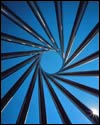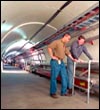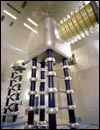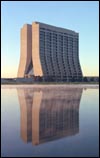Home Page Images
 |
Tractricious
Designed by founding director Robert Rathbun Wilson and constructed by members of the Technical Support Section, the Tractricious sculpture sits in front of the Industrial Complex. The structure is composed of 16 stainless steel outer tubes, made of scrap cryostat tubes from Tevatron magnets, and 16 inner pipes from old well casings. Each tube is freestanding, and the structure is designed to withstand winds of up to 80 mph.
|
 |
The Tevatron
With its 1,000 superconducting magnets, and four-mile circumference, the Tevatron is the world's highest-energy particle accelerator. The cryogenic cooling system, largest in the world when it was completed, was designated a national landmark by the American Society of Mechanical Engineers in 1993. The massive top quark was discovered at the Tevatron in 1995, and Collider Run II currently underway holds the promise of more discoveries that could change our understanding of nature and the universe. Inside the Tevatron, protons and antiprotons moving at near-light speed are brought into collision inside massive particle detectors, which track and record the collision products to provide the data scientists need for research.
|
 |
The Cockcroft-Walton
It looks as if it belongs in an old Flash Gordon serial, and the Cockcroft-Walton preaccelerator actually dates from that era. The original accelerator built by John Cockcroft and Ernest Walton produced the first artificial nuclear reaction in 1932. This is where the Fermilab particle beam originates. Hydrogen gas is ionized by an electrical charge of 750,000 electron volts, and the resulting ions begin their journey through the accelerator complex. This classic multistage diode/capacitor voltage multiple is probably the most popular means of generating high voltages at low currents, and at low cost. It is used in virtually every television set made to generate the 20-30 kV second anode accelerating voltage, from a transformer putting out 10-15 kV pulses. It has the advantage of requiring relatively low-cost components, and being easy to insulate.
|
 |
NuTeV Result
With the NuTeV detector as background, Northwestern University graduate student Sam Zeller (left) and Columbia University physicist Mike Shaevitz (right) review a new result with Kevin McFarland of the University of Rochester. The NuTeV experiment found a surprising discrepancy between predictions for the behavior of neutrinos, and the way the subatomic particles actually behave. Although the difference is tiny, it is the kind of inconsistency that has potentially far-reaching implications in requiring changes in the 30-year-old Standard Model of particle interactions.
|
 |
Buffalo
Technically, they're American bison, but by either name they stand as a powerful symbol of Fermilab's position at the frontiers of high-energy physics, and of the laboratory's link to the Illinois prairie heritage. Founding director Robert Wilson established Fermilab's standing herd, with an average annual population of just under 50. New calves are born each spring, providing yet new symbols of growth and renewal.
|
 |
Wilson Hall
A Gothic cathedral in Beauvais, France inspired the design for the laboratory's 16-story headquarters building. Wilson Hall actually consists of two connected towers, each able to move to absorb the stresses of wind and weather. The east and west towers, and north and south crossovers, surround a skylighted atrium that soars to the full 238-foot height of the building. Wilson Hall also houses Ramsey Auditorium, an 800-seat venue suitable for arts presentations and for meetings of experiment collaborations that can number several hundred physicists.
|
|